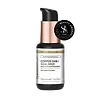What's inside
What's inside
 Key Ingredients
Key Ingredients

 Benefits
Benefits

 Concerns
Concerns

No concerns
 Ingredients Side-by-side
Ingredients Side-by-side

Water
Skin ConditioningGlycerin
HumectantEctoin
Skin ConditioningPolyglyceryl-10 Oleate
Skin ConditioningCoco-Caprylate/Caprate
EmollientIsononyl Isononanoate
EmollientDimethyl Isosorbide
SolventPanthenol
Skin ConditioningCarnitine
CleansingTocopherol
AntioxidantCopper Tripeptide-1
Skin ConditioningOxidized Glutathione
EmollientErgothioneine
AntioxidantTropolone
Skin ConditioningCopper Lysinate/Prolinate
Skin ConditioningAcetyl Hexapeptide-8
HumectantMethylglucoside Phosphate
Skin ConditioningHydroxyethylcellulose
Emulsion StabilisingSaccharide Isomerate
HumectantEthylhexylglycerin
Skin ConditioningSodium Gluconate
Skin ConditioningSclerotium Gum
Emulsion StabilisingDisodium Phosphate
BufferingSodium Phosphate
BufferingCaprylyl Glycol
EmollientPropanediol
Solvent1,2-Hexanediol
Skin ConditioningHydroxyethyl Acrylate/Sodium Acryloyldimethyl Taurate Copolymer
Emulsion StabilisingCitric Acid
BufferingPolysorbate 60
EmulsifyingSodium Hydroxide
BufferingPolysorbate 20
EmulsifyingPhenoxyethanol
PreservativeWater, Glycerin, Ectoin, Polyglyceryl-10 Oleate, Coco-Caprylate/Caprate, Isononyl Isononanoate, Dimethyl Isosorbide, Panthenol, Carnitine, Tocopherol, Copper Tripeptide-1, Oxidized Glutathione, Ergothioneine, Tropolone, Copper Lysinate/Prolinate, Acetyl Hexapeptide-8, Methylglucoside Phosphate, Hydroxyethylcellulose, Saccharide Isomerate, Ethylhexylglycerin, Sodium Gluconate, Sclerotium Gum, Disodium Phosphate, Sodium Phosphate, Caprylyl Glycol, Propanediol, 1,2-Hexanediol, Hydroxyethyl Acrylate/Sodium Acryloyldimethyl Taurate Copolymer, Citric Acid, Polysorbate 60, Sodium Hydroxide, Polysorbate 20, Phenoxyethanol
Water
Skin ConditioningButylene Glycol
HumectantTocophersolan
AntioxidantHyaluronic Acid
HumectantAlcohol Denat.
AntimicrobialCaprylyl Glycol
EmollientCaprylic/Capric Triglyceride
MaskingCopper Tripeptide-1
Skin ConditioningPhospholipids
Skin ConditioningTocopherol
AntioxidantBakuchiol
AntimicrobialTetrahexyldecyl Ascorbate
AntioxidantLavandula Angustifolia Oil
MaskingTetrahydrocurcumin 95%
AntioxidantAstragalus Membranaceus Root Extract 98%
EmollientIngredients Explained
These ingredients are found in both products.
Ingredients higher up in an ingredient list are typically present in a larger amount.
Caprylyl Glycol is a humectant and emollient, meaning it attracts and preserves moisture.
It is a common ingredient in many products, especially those designed to hydrate skin. The primary benefits are retaining moisture, skin softening, and promoting a healthy skin barrier.
Though Caprylyl Glycol is an alcohol derived from fatty acids, it is not the kind that can dry out skin.
This ingredient is also used as a preservative to extend the life of products. It has slight antimicrobial properties.
Learn more about Caprylyl GlycolCopper Tripeptide-1 (GHK-Cu) is a skin repairing ingredient known for its ability to boost collagen, improve firmness, and support skin regeneration.
It is a complex made up of a naturally occurring peptide (glycine-histidine-lysine) and copper, an essential trace element.
While studying wound healing, researchers noticed GHK-Cu stimulated hair follicle enlargement and growth by keeping hair in its active growth phase longer. This has made it a promising ingredient for hair regrowth treatments.
Some people have reported increased facial hair. While GHK-Cu can make your hair follicles bigger, it usually doesn’t turn soft, barely-visible facial hairs into thick, dark ones.
Anecdotal reports suggest that overusing copper peptides might lead to premature aging due to excess free copper or enzyme imbalances. This claim isn’t backed by large-scale studies.
Unfortunately, there are limited human studies for this ingredient. While early results are promising, many studies are either small, in-vitro, or not rigorously controlled.
For example, there is a 1998 study that explored the effects of copper tripeptide, vitamin C, tretinoin, and melatonin on skin repair and collagen synthesis.
After one month, increased procollagen production was seen in 7 out of 10 participants using copper tripeptide (more than those using vitamin C, melatonin, or tretinoin.
While the study was exploratory, it offers early evidence that copper tripeptide may support collagen production. Larger, well-designed trials are still needed to confirm its potential and understand individual responses.
Read more about other common types of peptides here:
Learn more about Copper Tripeptide-1Tocopherol (also known as Vitamin E) is a common antioxidant used to help protect the skin from free-radicals and strengthen the skin barrier. It's also fat soluble - this means our skin is great at absorbing it.
Vitamin E also helps keep your natural skin lipids healthy. Your lipid skin barrier naturally consists of lipids, ceramides, and fatty acids. Vitamin E offers extra protection for your skin’s lipid barrier, keeping your skin healthy and nourished.
Another benefit is a bit of UV protection. Vitamin E helps reduce the damage caused by UVB rays. (It should not replace your sunscreen). Combining it with Vitamin C can decrease sunburned cells and hyperpigmentation after UV exposure.
You might have noticed Vitamin E + C often paired together. This is because it is great at stabilizing Vitamin C. Using the two together helps increase the effectiveness of both ingredients.
There are often claims that Vitamin E can reduce/prevent scarring, but these claims haven't been confirmed by scientific research.
Learn more about TocopherolWater. It's the most common cosmetic ingredient of all. You'll usually see it at the top of ingredient lists, meaning that it makes up the largest part of the product.
So why is it so popular? Water most often acts as a solvent - this means that it helps dissolve other ingredients into the formulation.
You'll also recognize water as that liquid we all need to stay alive. If you see this, drink a glass of water. Stay hydrated!
Learn more about Water